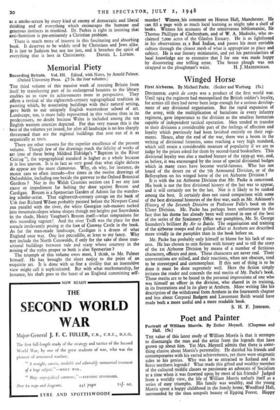Poet and Painter
Portrait of William Morris. By Esther Meynell. (Chapman and Hall. 15s.)
THE value of this latest study of William Morris is that it attempts to disentangle the man and the artist from the legends that have grown up about him. Yet Mrs. Meynell admits that there is some- thing elusive about Morris's personality. He dazzled his friends and contemporaries with his varied achievements, yet there were enigmatic sides to his genius. Why was he so attracted to Iceland and its fierce northern legends? What made this gifted and wealthy member of the cultured middle classes so passionate an advocate of Socialism at a time when it was frowned upon by most of his friends? Judged from a worldly view, the life of William Morris unfurls itself_as a series of .easy triumphs. His family was wealthy, and the young Morris spent a happy childhood in the family home, Woodford Hall, surrounded by the then, unspoilt beauty of Epping Forest. Happy
schooldays at Marlborough followed, and then he went up to Oxford. At this time it was thought that the young man might enter the Church, and whilst he was at Exeter College he met another young man, Edward Burne-Jones, who was also destined for holy orders. A great friendship sprang up between the two.
Oxford, at this period, was the ideal setting for such a friendship and collaboration. Both men soon forgot their earlier idea of enter- ing the Church and plunged into a passionate study of poetry, archi- tecture and romantic history. As Morris's new biographer writes: " Ruskin and Tennyson were great prophets in those days. Ruskin was destined to influence Burne-Jones's life more strongly than that of Morris, but Modern Painters was important to them both." One of the results of these studies was that Morris suddenly began to write poetry. It seemed to come easily to him, and his friends were amazed at his natural mastery of verse. Then the two friends met Dante Gabriel Rossetti. Through Rossetti both Morris and Burne- Jones were introduced to the doctrines of the Pre-Raphaelite Move- ment. Rossetti also persuaded Morris to take up painting, for which the young man showed the same natural ability as he had already displayed in the writing of poetry. Even today Morris's La Belle Iseult remains one of the loveliest examples of Pre-Raphaelite painting.
From then onwards Morris's life sweeps on from one success to another. He marries his ideal of a wife, Jane Burden. He takes up architecture and designing and creates his own ideal home—first in The Red House and then in the two ver- sions of Kelmscott. He discovers Iceland and writes his great sagas about the Icelandic legends. He revolutionises domestic design with his firm of Morris and Co. Finally, he takes up printing and launches the famous Kelmscott Press and prints amongst other books his superb edition of Chaucer. Mrs. Meynell describes this triumphant progress with great insight and with a wealth of care- fully selected and interesting material ; but at the end of her bio- graphy she is forced to admit that there is a sense of frustration about her hero. " He was always struggling with a world in which







































 Previous page
Previous page